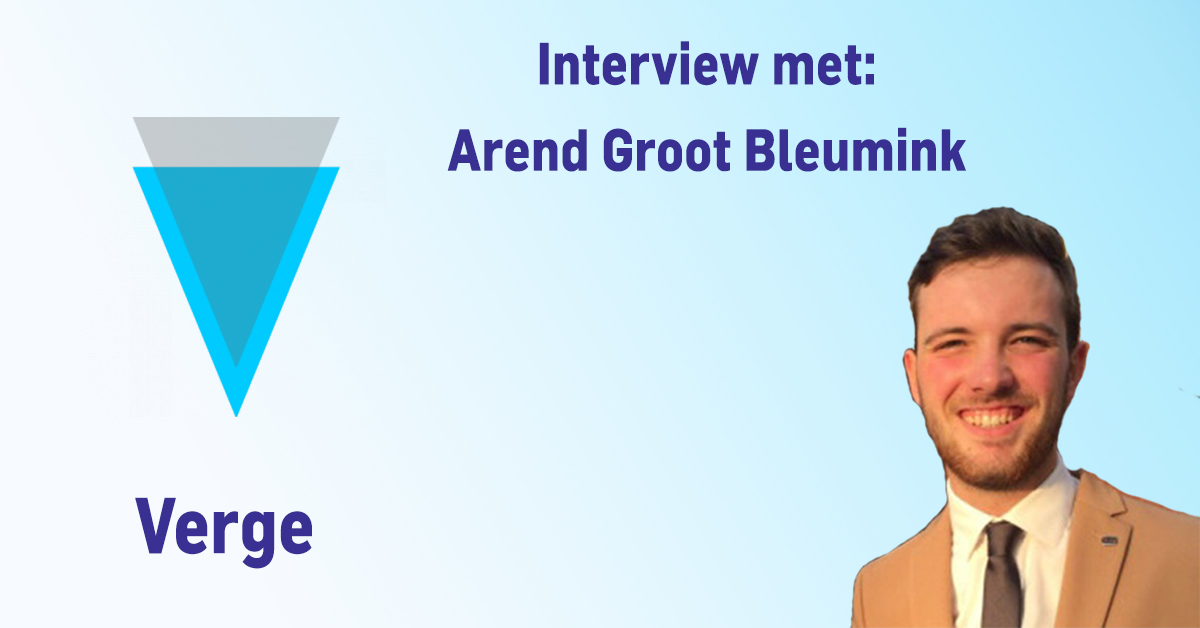Last October, Arend Groot Bleumink gave a presentation during one of the world’s biggest Blockchain events in Barcelona about ‘Verge’. Not even two years ago, the 20 year old Tilburg University student became interested in the topic of cryptocurrency. After watching clips on YouTube about making money through investments, het got in touch with the topic of cryptocurrencies. As he started to understand the cryptocurrency market better and better, he realized himself that in this market it is not just about money. Rather, the whole digital coin market is an interesting topic. We had the opportunity to interview Arend. He told us about Verge and his role in this multimillion cryptocurrency project ran by volunteers.
“The idea of cryptocurrencies is that you can use them as a payment method, yet right now people see them as a speculation. We have to move from this stage of speculation to a stage where people actually use cryptocurrencies as a payment method.”
What is Verge?
When Verge was founded, the project’s required capital was financed by its volunteers. This is what makes Verge quite unique, since it is very common to finance such projects through an Initial Coin Offering (ICO). The project’s focus is providing privacy to those who make transactions with digital coins. In the case of other cryptocurrencies there often exists a lack of privacy. This holds, amongst others, for the Bitcoin. Bitcoin transactions can be traced through ip-addresses, which allows for seeing who received the Bitcoin(s). Verge has improved this by implementing ‘Tor’ in its Blockchain technology, which hides ip-addresses in a transaction. Therefore, in the case of Verge we can speak of a ‘privacy coin’. Verge has chosen to use an open Blockchain which allows companies to see where the transaction came from, and when the coins in a transaction have arrived. At the moment, there are about 160 companies which accept the Verge’s own coin as a payment method.
How do you interpret the value of the cryptomarket?
Back when the crypto market experienced its peak, the project was worth about 3.5 billion dollars. However, after a steep decline of the crypto market, the value has decreased to about 100 million dollars. In 2017, cryptocurrencies were growing enormously; it looked like a revolution was going on. Yet, this period of growth stopped abruptly. Arend, who has the function of Payment Integration Manager at Verge, was not surprised by this decline. “The idea of cryptocurrencies is that you can use them as a payment method, yet right now people see them as a speculation. We have to move from this stage of speculation to a stage where people actually use cryptocurrencies as a payment method.” After the decline of the market, the market got restructured as well; many crypto projects stopped existing. Obviously, digital coins do not have a lot of worth if there is no possibility to pay with them. This is exactly what has to change; the more transactions that will be made with cryptocurrencies, the larger their demand.
“Obviously, it would be amazing if people get their groceries at the local supermarket and are able to pay with digital coins within a few seconds.”
In what way distinguishes Verge itself from others and what is your role within the company?
As a Payment Integration Manager of the Verge, the focus of Arend is helping organizations integrate Verge on a technical and non-technical level and helping with strategic partnerships as well as collaborations to further adopt Verge. He tries to speak at a lot of conferences to enlighten as many people as possible about blockchain and crypto. At the end of this month Arend has a lecture at the Markethings week with the goal of getting students become acquainted with Verge. Verge would like to continuously distinguish itself by educating people about cryptocurrencies and by being integrated in many companies. It will take years before cryptocurrencies are fully integrated and will be seen as a common payment method. However, more and more companies join this trend. For example, in some cases you can pay for your Uber rides with digital coins already.
Arend is sure that this rise of integration will happen and told us: “Obviously, it would be amazing if people get their groceries at the local supermarket and are able to pay with digital coins within a few seconds. However, before this can be realized, people have to understand that cryptocurrencies are a method of payment rather than a means of investment and speculation”.

















